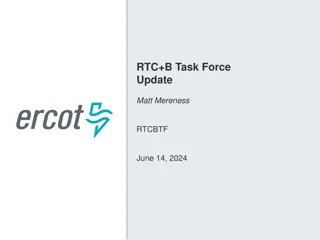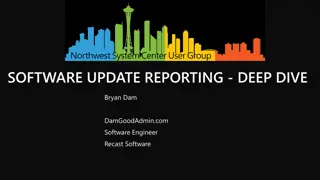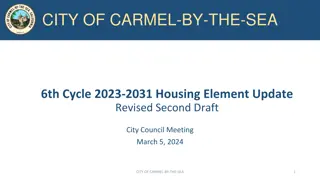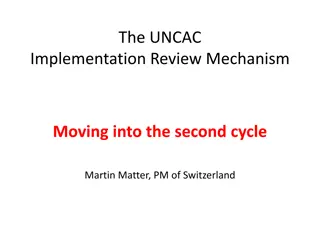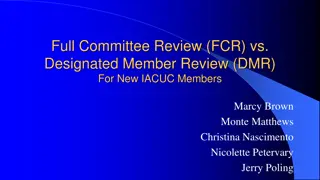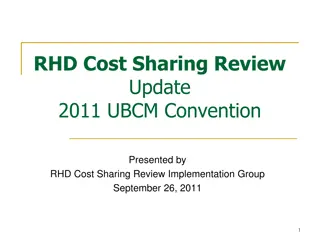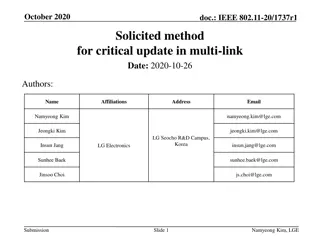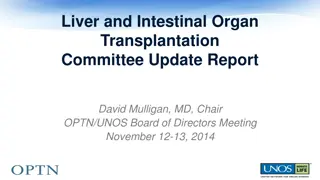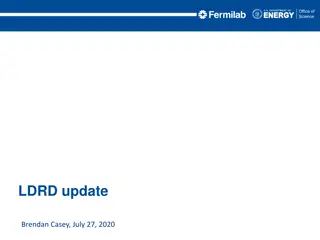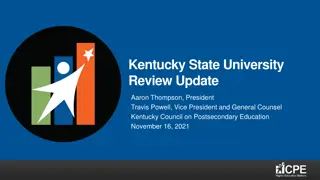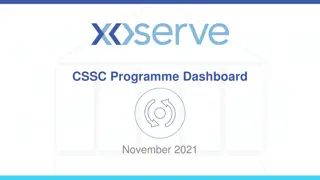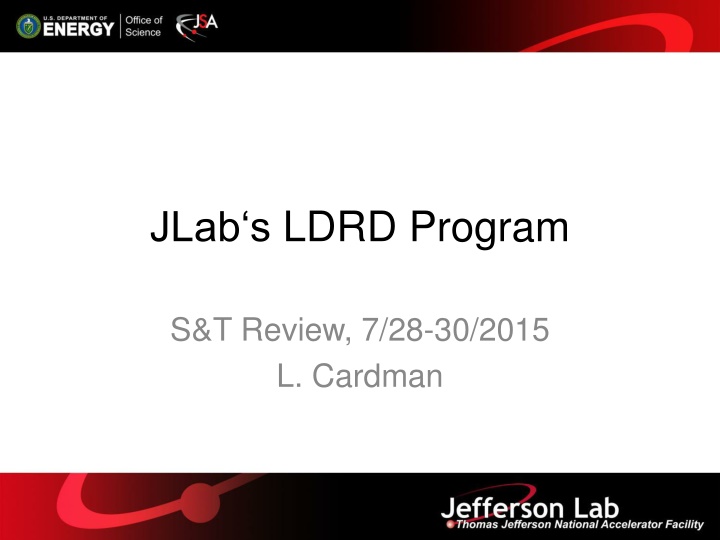
Overview of JLabs LDRD Program and Current Projects
JLabs initiated the LDRD (Laboratory Directed Research and Development) Program in FY2014 with a modest budget of around $800k. The program began with three 2-year projects in November 2014. As of the last S&T Review in July 2015, the FY2014 projects were progressing well, with three new FY2015 projects also underway. The summary includes details of the projects, budgets, and division leads involved, highlighting the focus on physics and accelerator research. Evaluation for FY2016 projects is currently in progress.
Download Presentation

Please find below an Image/Link to download the presentation.
The content on the website is provided AS IS for your information and personal use only. It may not be sold, licensed, or shared on other websites without obtaining consent from the author. If you encounter any issues during the download, it is possible that the publisher has removed the file from their server.
You are allowed to download the files provided on this website for personal or commercial use, subject to the condition that they are used lawfully. All files are the property of their respective owners.
The content on the website is provided AS IS for your information and personal use only. It may not be sold, licensed, or shared on other websites without obtaining consent from the author.
E N D
Presentation Transcript
JLabs LDRD Program S&T Review, 7/28-30/2015 L. Cardman
Introduction JLab initiated an LDRD Program in FY2014 The scale is modest, ~$800k ( a 1% tax on direct costs) It began with three 2-year Projects in November 2014 (the late start was due to budget delays) At the time of your last (July, 2014) S&T Visit the three FY2014 projects were underway and the evaluation process for the FY2015 projects was nearly complete. Since then: The three projects started in FY2014 were enthusiastically endorsed for continuation and completion in FY2015; they are progressing nicely toward their finish in two months. Three new FY2015 projects were started (Two are 1-year only; one is planned as a 2-year project) Evaluation of proposals for FY2016 projects is well underway My goals today are to: Summarize the LDRD projects now underway; Describe the funding framework; and Introduce the new set of proposals for FY2016 funding that are now under evaluation S and T Review July 28-30, 2015
FY2014 and FY2015 LDRD Projects Underway FY14 Budget (Actuals) FY16 Budget (Proposed) Lead Division FY15 Budget Total Budget LDRD Project # Submitted By Title FY2014 Start Physics_Wireless, Data Acquisition System for Imaging Detector 2014-LDRD-3 Jack McKisson Physics $61,700 $59,407 $121,107 Christian WeissPhysics potential of polarized light ions with EIC@JLab Physics / Theory 2014-LDRD-6 $146,800 $168,252 $315,052 Ed Nissen, then Andrew Kimber Development of a prototype for a fast RF kicker for the MEIC electron cooler 2014-LDRD-10 Accelerator $9,500 $153,574 $163,074 FY2015 Start 2015-LDRD-1a Yuhong Zhang Cooling by a bunched beam Accelerator $88,826 $88,826 Coherent Synchrotron Radiation Suppression experiment 2015-LDRD-1b Yves Roblin Accelerator $198,163 $198,163 Enhancing Simulation Capability for Electron Cooling in MEIC Project 2015-LDRD-7 He Zhang Accelerator $130,582 $135,085 $265,667 Totals All Projects $218,000 $798,804 $135,085 $1,151,889 S and T Review July 28-30, 2015
FY2014 and FY2015 LDRD Projects Underway FY14 Budget (Actuals) FY16 Budget (Proposed) Lead Division FY15 Budget Total Budget LDRD Project # Submitted By Title FY2014 Start Physics_Wireless, Data Acquisition System for Imaging Detector 2014-LDRD-3 Jack McKisson Physics $61,700 $59,407 $121,107 Christian WeissPhysics potential of polarized light ions with EIC@JLab Physics / Theory 2014-LDRD-6 $146,800 $168,252 $315,052 Ed Nissen, then Andrew Kimber Development of a prototype for a fast RF kicker for the MEIC electron cooler 2014-LDRD-10 Accelerator $9,500 $153,574 $163,074 FY2015 Start 2015-LDRD-1a Yuhong Zhang Cooling by a bunched beam Accelerator $88,826 $88,826 Coherent Synchrotron Radiation Suppression experiment 2015-LDRD-1b Yves Roblin Accelerator $198,163 $198,163 Enhancing Simulation Capability for Electron Cooling in MEIC Project 2015-LDRD-7 He Zhang Accelerator $130,582 $135,085 $265,667 Totals All Projects $218,000 $798,804 $135,085 $1,151,889 Two Examples (Summaries of all 6 Projects are in Backup Material) S and T Review July 28-30, 2015
2014-DRD-4: C. Weiss: Physics Potential of Polarized Light Ions with EIC@JLab Overview D. Higinbotham, P. Nadel-Turonski (JLab Physics), W. Melnitchouk, C. Weiss* (JLab Theory) Visiting Scientists: W. Cosyn (Ghent U), V. Guzey (Petersburg NPI), M. Sargsian (FIU) Postdoc: K. Park (Old Dominion U, 50% FTE) Objective: Enable next-generation nuclear physics measurements using polarized light ions (deuteron, 3He) and forward spectator tagging with the JLab medium energy Electron Ion Collider design Fundamental nuclear physics questions of EIC White Paper: Neutron structure, nuclear binding in QCD, collective fields Innovative method using unique capabilities of JLab MEIC: Polarized deuteron, forward detection Strong interest among JLab Users Tasks Tasks Develop simulation tools: Theoretical models, event generators Perform process simulations with EIC accelerator and detector configuration Quantify physics impact and disseminate results S and T Review July 28-30, 2015
2014-DRD-4: C. Weiss: Physics Potential of Polarized Light Ions with EIC@JLab Progress to date Developed theoretical cross section models for high-energy eD scattering at EIC with spectator tagging: unpolarized, polarized, diffractive final state FORTRAN/C++ codes, documentation, publicly available at https://www.jlab.org/theory/tag/ Developed Monte-Carlo simulation tools (event generators, analysis tools) for high-energy eD scattering at EIC with spectator tagging Maintained on github area, can be adapted by users Performed process simulations with EIC beam and detector configuration and demonstrated feasibility of precise neutron structure measurements Counting rate estimates, statistical errors Systematic errors: Momentum resolution, polarization, analysis procedures Preliminary results published in proceedings: arXiv:1407.3236, arXiv:1409.5768, journal article in preparation Reached out to JLab Users and broader nuclear physics community Project results presented at 2014 DNP Town Meeting Recent results: Neutron spin structure with EIC Precision measurements of neutron spin structure in eD with proton tagging On-shell extrapolation in recoil proton momentum eliminates nuclear binding and deuteron D-wave contamination Neutron data permit u-d flavor separation of quark spin and accurate determination of gluon spin Prepared for EIC Long-Range Plan presentation 6 S and T Review July 28-30, 2015
Project outline 2014-LDRD-10: A. Kimber: Fast RF Kicker One or more fast RF kickers would be employed to kick single electron bunches in and out of a bunch train. At 750 MHz bunch rate, a kicker would have to operate at sub nanosecond rise and fall times and at much higher repetition rates than has been demonstrated. Mathematically, the concept works by summing simple sine waves at sub-frequencies of the final beam repetition frequency* to generate the required waveform. Goals: To demonstrate (by experiment) that a stripline kicker can be driven with a waveform shown below and to investigate it s real world performance. To make recommendations as to the technology that should be employed on the full scale MEIC project. MEIC proposal uses electron cooling to attain design luminosity Energy recovery and the reuse of cooling bunches help with the design requirements of both the injector and beam dump 1 DC offset 0.5 DC offset 375 Mhz, 1 pk-pk 250 Mhz, 0.89 pk-pk 500 Mhz, 0.44 pk-pk 375 Mhz, 0.5 pk-pk 300 Mhz, 0.48 pk-pk 250 Mhz, 0.44 pk-pk 214.3 Mhz, 0.41 pk-pk 187.5 Mhz, 0.38 pk-pk 166.7 Mhz, 0.35 pk-pk 150 Mhz, 0.32 pk-pk 136.4 Mhz, 0.3 pk-pk 0.33 DC offset 0.25 DC offset 0.2 DC offset 0.17 DC offset 0.14 DC offset 0.13 DC offset 0.11 DC offset 0.1 DC offset 0.09 DC offset 750 Mhz bunches, 1 in 1 bunches kicked 750 Mhz bunches, 1 in 2 bunches kicked 750 Mhz bunches, 1 in 3 bunches kicked 750 Mhz bunches, 1 in 4 bunches kicked 750 Mhz bunches, 1 in 5 bunches kicked 750 Mhz bunches, 1 in 6 bunches kicked 750 Mhz bunches, 1 in 7 bunches kicked 750 Mhz bunches, 1 in 8 bunches kicked 750 Mhz bunches, 1 in 9 bunches kicked 750 Mhz bunches, 1 in 10 bunches kicked 750 Mhz bunches, 1 in 11 bunches kicked 187.5 Mhz, 0.75 pk-pk 150 Mhz, 0.64 pk-pk 125 Mhz, 0.56 pk-pk 107.1 Mhz, 0.49 pk-pk 93.8 Mhz, 0.44 pk-pk 83.3 Mhz, 0.4 pk-pk 75 Mhz, 0.36 pk-pk 68.2 Mhz, 0.33 pk-pk 562.5 Mhz, 0.25 pk-pk 450 Mhz, 0.32 pk-pk 375 Mhz, 0.33 pk-pk 321.4 Mhz, 0.33 pk-pk 281.3 Mhz, 0.31 pk-pk 250 Mhz, 0.3 pk-pk 225 Mhz, 0.28 pk-pk 204.5 Mhz, 0.26 pk-pk 600 Mhz, 0.16 pk-pk 500 Mhz, 0.22 pk-pk 428.6 Mhz, 0.24 pk-pk 375 Mhz, 0.25 pk-pk 333.3 Mhz, 0.25 pk-pk 300 Mhz, 0.24 pk-pk 272.7 Mhz, 0.23 pk-pk 625 Mhz, 0.11 pk-pk 535.7 Mhz, 0.16 pk-pk 468.8 Mhz, 0.19 pk-pk 416.7 Mhz, 0.2 pk-pk 375 Mhz, 0.2 pk-pk 340.9 Mhz, 0.2 pk-pk 642.9 Mhz, 0.08 pk-pk 562.5 Mhz, 0.13 pk-pk 500 Mhz, 0.15 pk-pk 450 Mhz, 0.16 pk-pk 409.1 Mhz, 0.17 pk-pk 656.3 Mhz, 0.06 pk-pk 583.3 Mhz, 0.1 pk-pk 525 Mhz, 0.12 pk-pk 477.3 Mhz, 0.13 pk-pk 666.7 Mhz, 0.05 pk-pk 600 Mhz, 0.08 pk-pk 545.5 Mhz, 0.1 pk-pk 675 Mhz, 0.04 pk-pk 613.6 Mhz, 0.07 pk-pk 681.8 Mhz, 0.03 pk-pk *Concept originally proposed by Dr. Hutton S and T Review July 28-30, 2015 Slide 7/6
Fast RF kicker update 2014-LDRD-10: A. Kimber: Fast RF Kicker 0.17 DC offset 750 Mhz bunches, 1 in 6 bunches kicked 125 Mhz, 0.56 pk-pk 250 Mhz, 0.44 pk-pk 375 Mhz, 0.33 pk-pk 500 Mhz, 0.22 pk-pk 625 Mhz, 0.11 pk-pk Summed waveform demonstrated using 5 signal generators, summed, amplified and attenuated, measured by a fast oscilloscope. Experimental results show good agreement with the simulated waveform A Goubau line setup on the bench with a stripline cavity, on loan from SLAC The Goubau line is used at JLab to qualify beam position monitors, it will be used here to simulate the presence of an electron beam. We will quantify the coupling between the cavity electrodes and the line. Further studies will be performed by launching the summed waveform along the cavity electrodes and measuring the effect on the simulated electron beam. S and T Review July 28-30, 2015 Slide 8/6
Financial Envelope Our Goal for the JLab LDRD program has been a budget envelope of ~$800k/year (including overhead) The total costs of the program to date have been: $218k in FY14 $798k in FY15 (including continuation of 3 projects started in FY14) Our plan is to keep the budget for FY16 below $800k (including possible continuation of one FY15 project) We continue to watch the out-year implications of the projects we fund to keep room in the budget for new proposals each year So, for example, we limited the number of proposals funded in the initial year (FY14) so that the program had room to grow to a total of ~$800k/year including both new and continuing projects We anticipate a similar approach this year Our experience to date suggests that this overall level of LDRD funding is about right for JLab S and T Review July 28-30, 2015
The FY16 LDRD Program FY15 Review Cycle was launched on February 13th with Call for Proposals (and optional LOIs) Five LOIs were received and evaluated Eight Proposals were received, and are currently under evaluation The major presentation session and initial rank ordering occurred on July 1 and the formal reviews and recommendations to the Director will be completed by mid-August. Evaluation of proposals for FY16 includes evaluation of the value of continuing the one multi-year proposal launched in the FY15 cycle (they have submitted a renewal proposal that include a section that is basically a progress report) S and T Review July 28-30, 2015
8 Proposals Were Received for FY16 Covering a Broad Variety of Topics; Evaluation is Nearing Completion Proposal # Lead Division FY15 Renewal? Submitted By Title 2016- LDRD-1 Enhancing Simulation Capability for Electron Cooling in MEIC Project He Zhang Accelerator Yes Generation and Characterization of Magnetized Bunched Electron Beam from DC Photogun for MEIC Cooler (Revised) 2016- LDRD-2a Riad Suleiman and Matt Poelker Accelerator 2016- LDRD-3 Alex Bogacz Lattice Mitigations of Luminosity Limits for MEIC Accelerator 2016- LDRD-4a Christian Weiss Nuclear gluons with charm at EIC Theory 2016- LDRD-5 Studies of the Structure of the Nucleon and Hadronization in Correlations of Hadrons in CFR and TFR Harut Avagyan Physics 2016- LDRD-6 Alexandre Camsonne Superconducting detectors Physics Experimental Investigation of Longitudinal Space Charge (LSC) and Coherent Synchrotron Radiation (CSR) Induced Microbunching Instability Using LERF 2016- LDRD-7 Rui Li Accelerator 2016- LDRD-8 Jiquan Guo Experimental Study of CEBAF Pulsed Beam Operation Accelerator S and T Review July 28-30, 2015
Summary JLab s LDRD program, which began in FY2014, is now in full swing A total of six projects are underway (three begun in FY2014 and continued in FY2015, and three begun in FY2015) Five of these six projects are nearing completion as planned (2 months to go); the sixth plans a second year in FY2016 We are now in our third evaluation cycle, and continue to be impressed by the level of innovation and clear thinking presented in the proposals we have received The LDRD program is making substantive contributions to the future evolution of the laboratory and its science, and we are delighted with its progress S and T Review July 28-30, 2015


